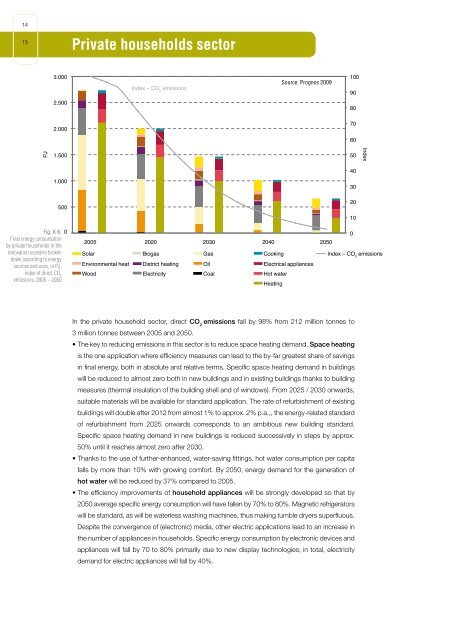Blueprint Germany - Öko-Institut eV
Blueprint Germany - Öko-Institut eV
Blueprint Germany - Öko-Institut eV
Create successful ePaper yourself
Turn your PDF publications into a flip-book with our unique Google optimized e-Paper software.
14<br />
15<br />
PJ<br />
3.000<br />
2.500<br />
2.000<br />
1.500<br />
1.000<br />
500<br />
Fig. K 6:<br />
Final energy consumption<br />
by private households in the<br />
innovation scenario broken<br />
down according to energy<br />
sources and uses, in PJ,<br />
index of direct CO 2<br />
emissions, 2005 – 2050<br />
0<br />
Private households sector<br />
Index – CO 2 emissions<br />
2005 2005 2005 2020 2020 2020 2030 2030 2030 2040 2040 2040 2050 2050 2050<br />
Solar<br />
Environmental heat<br />
Wood<br />
Biogas<br />
District heating<br />
Bruttoinlandsprodukt<br />
Electricity<br />
In the private household sector, direct CO 2 emissions fall by 98% from 212 million tonnes to<br />
3 million tonnes between 2005 and 2050.<br />
Gas<br />
Oil<br />
Coal<br />
Source: Prognos 2009<br />
Cooking<br />
Electrical appliances<br />
Hot water<br />
Heating<br />
• The key to reducing emissions in this sector is to reduce space heating demand. Space heating<br />
Index – CO 2 emissions<br />
is the one application where efficiency measures can lead to the by-far greatest share of savings<br />
in final energy, both in absolute and relative terms. Specific space heating demand in buildings<br />
will be reduced to almost zero both in new buildings and in existing buildings thanks to building<br />
measures (thermal insulation of the building shell and of windows). From 2025 / 2030 onwards,<br />
suitable materials will be available for standard application. The rate of refurbishment of existing<br />
buildings will double after 2012 from almost 1% to approx. 2% p.a.,, the energy-related standard<br />
of refurbishment from 2025 onwards corresponds to an ambitious new building standard.<br />
Specific space heating demand in new buildings is reduced successively in steps by approx.<br />
50% until it reaches almost zero after 2030.<br />
• Thanks to the use of further-enhanced, water-saving fittings, hot water consumption per capita<br />
falls by more than 10% with growing comfort. By 2050, energy demand for the generation of<br />
hot water will be reduced by 37% compared to 2005.<br />
• The efficiency improvements of household appliances will be strongly developed so that by<br />
2050 average specific energy consumption will have fallen by 70% to 80%. Magnetic refrigerators<br />
will be standard, as will be waterless washing machines, thus making tumble dryers superfluous.<br />
Despite the convergence of (electronic) media, other electric applications lead to an increase in<br />
the number of appliances in households. Specific energy consumption by electronic devices and<br />
appliances will fall by 70 to 80% primarily due to new display technologies; in total, electricity<br />
demand for electric appliances will fall by 40%.<br />
100<br />
90<br />
80<br />
70<br />
60<br />
50<br />
40<br />
30<br />
20<br />
10<br />
0<br />
Index

















